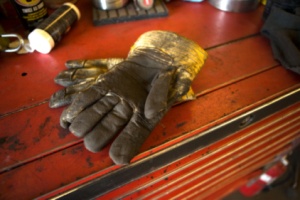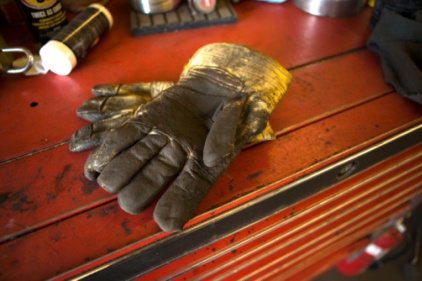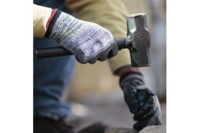 Work gloves
Work gloves
· Leather - sparks, moderate heat, blows, chips, and rough objects
· Metal mesh (aluminized) – heat (require an insert of synthetic materials)
· Canvas (aramid fiber and other synthetic materials) – heat and cold, cut and abrasion resistant
Fabric and coated gloves
· Cotton and other fabric - dirt, slivers, chafing, and abrasion
· Cotton flannel coated with plastic – general purpose protection with slip resistance
Chemical and liquid resistant gloves
o Butyl Rubber- acids, peroxide, rocket fuels, bases, alcohols, aldehydes, ketones, esters, nitro-compounds
§ Resist oxidation and ozone corrosion
§ Resist abrasion and remain flexible in cold
o Natural Latex Rubber- water solutions of acid, alkalis, salts, and ketones
§ Resist abrasions caused by sandblasting, grinding, and polishing
§ Good tensile strength, elasticity, and temperature resistance
§ May cause allergic reactions in some
o Neoprene- hydraulic fluids, gasoline, alcohols, organic acids, and alkalis
§ Better chemical and wear resistance than natural latex rubber
§ Good pliability , finger dexterity, high density and tear resistance
o Nitrile Rubber- chlorinated solvents, oils, greases, acids, caustics, and alcohols
§ Provide good dexterity and sensitivity, durable to heavy use
Insulating rubber gloves
Rreferred to under 29 CFR 1910.137, “Electrical Protective Equipment”8
The Occupational Safety and Health Technical Reference Manual contains a chart from the U.S. Department of Energy, titled, “Chemical Resistance Selection Chart for Protective Gloves.” According to OSHA/VOSH this chart “rates various gloves as being protective against specific chemicals and will help you select the most appropriate gloves to protect your employees.” It may be seen at http://www.osha.gov/Publications/osha3151.html.9
Training
As with all PPE, the employer must train each user to know at least when and what type of gloves are necessary, as well as how to properly put them on and take them off. Make the user aware of all of the limitations of the gloves plus how to inspect and when to replace them along with the proper means of disposal. If non-disposable gloves are used, then the user must also be instructed in cleaning, maintenance, and the proper way to store them. It is also important to emphasize that gloves should never be worn while using power tools or machines, such as saws. The glove may snag and pull the user’s hand into the blade or other danger area.10
Inspection and care of protective gloves
Protective gloves should be inspected before each use to make sure they will still provide the desired protection. Gloves that are punctured, torn, or otherwise damaged should be discarded and replaced. Chemical or liquid resistant gloves may become stiff or discolored, which is usually an indication of too much use and that the material may be breaking down. Things to take into account when considering reusing chemically exposed gloves are:
· The nature of the chemicals handled
· Amount of exposure
· Temperature
· How they are stored
The method of storage will depend on usage and environment. It is best to refer to the manufacturer’s guidelines for storage.
A simple method for visually testing the integrity of chemical or liquid resistant gloves is to fill the gloves with water and tightly roll the cuff towards the fingers. This will show any pinhole leaks.11
Be alert
Many people do not take the necessary care to adequately protect hands and arms from hazards. Lack of attention and human error are responsible for most hand, finger, wrist, and lower arm injuries.12 People generally have one dominant hand and may carelessly place the non-dominant hand in harm’s way while performing tasks. Many injuries occur to these “off-hands” when they are inadvertently placed or rested in a hazardous location.13 In addition to direct exposures, hazard assessments can help identify these secondary exposures and appropriate safeguards. However, even with physical safeguards in place, the best way to protect workers’ hands and arms is to maintain a high level of awareness and attention to dangers that could catastrophically alter lives.
1Construction Safety Association of Manitoba. “Hand Safety.” Retrieved February 16, 2007 from, http://www.constructionsafety.ca/pdf/20-HandSafety.pdf
2Business and Legal Reports. “Handy Tips for Hand Safety.” Retrieved February 16, 2007 from, http://safety.blr.com/display.cfm/id/98667
3U.S. Department of Labor, Occupational Safety and Health Administration. “OSHA standard, 29 CFR 1910.138.” Retrieved February 16, 2007 from, http://www.osha.gov/pls/oshaweb/owadisp.show_document?p_table=STANDARDS&p_id=9788
4U.S. Department of Labor, Occupational Safety and Health Administration. “OSHA standard, 29 CFR 1910.132.” Retrieved February 16, 2007 from, http://www.osha.gov/pls/oshaweb/owadisp.show_document?p_table=STANDARDS&p_id=9777
5U.S. Department of Labor, Occupational Safety and Health Administration. “Personal Protective Equipment.” Retrieved February 16, 2007 from, http://www.osha.gov/Publications/osha3151.pdf
6Ibid.
7Ibid.
8Ibid.
9Ibid.
10Ibid.
11Ibid.
12Construction Safety Association of Manitoba. “Hand Safety.” Retrieved February 16, 2007 from, http://www.constructionsafety.ca/pdf/20-HandSafety.pdf
13Maintenance World. “The Safety Catalyst.” Retrieved February 16, 2007 from, http://www.maintenanceworld.com/Articles/paterR/Safety-Catalyst.htm
References
Business and Legal Reports (n.d). Handy Tips for Hand Safety. Retrieved February 16, 2007 from, http://safety.blr.com/display.cfm/id/98667
Construction Safety Association of Manitoba (n.d). Hand Safety. Retrieved February 16, 2007 from, http://www.constructionsafety.ca/pdf/20-HandSafety.pdf
Maintenance World (12/2005). The Safety Catalyst. Retrieved February 16, 2007 from, http://www.maintenanceworld.com/Articles/paterR/Safety-Catalyst.htm
U.S. Department of Labor, Occupational Safety and Health Administration (n.d). Personal Protective Equipment. Retrieved February 16, 2007 from, http://www.osha.gov/Publications/osha3151.pdf
U.S. Department of Labor, Occupational Safety and Health Administration (n.d). OSHA standard, 29 CFR 1910.132. Retrieved February 16, 2007 from, http://www.osha.gov/pls/oshaweb/owadisp.show_document?p_table=STANDARDS&p_id=9777
U.S. Department of Labor, Occupational Safety and Health Administration (n.d). “OSHA standard, 29 CFR 1910.138. Retrieved February 16, 2007 from, http://www.osha.gov/pls/oshaweb/owadisp.show_document?p_table=STANDARDS&p_id=9788
Utah Safety Council (n.d). Hand Protection-PPE. Retrieved February 16, 2007 from, http://www.utahsafetycouncil.org/OFF%20THE%20JOB/Occupational%20Safety/PPE%20hand.html
Web World Inc (n.d). Protect Your Hands. Retrieved February 16, 2007 from, http://www.webworldinc.com/wes-con/hands.htm


